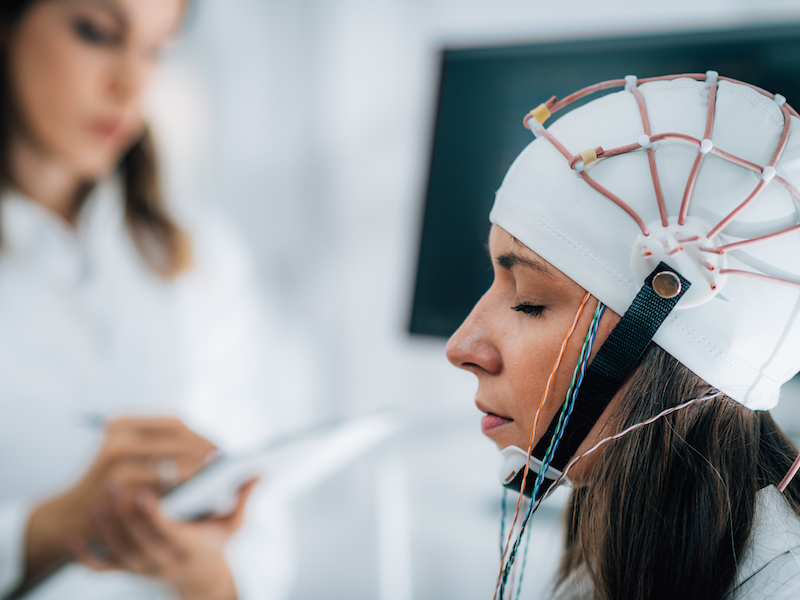
EEG – Electroencephalogram FAQ
EEG instructions – https://neurocenter.com/wp-content/uploads/2022/05/EEG-Instructions.pdf
EEG Spanish instructions – https://neurocenter.com/wp-content/uploads/2022/05/EEG-instructions-in-Spanish.pdf
Ambulatory EEG instructions – https://neurocenter.com/wp-content/uploads/2022/05/Ambulatory-EEG-Instructions.pdf
What is an EEG?
An electroencephalogram (EEG) is a painless procedure that uses small, flat metal discs (electrodes) attached to your scalp to detect electrical activity in your brain. Your brain cells communicate via electrical impulses and are active all the time, even when you’re asleep.
Why am I being sent for an EEG?
An EEG is one of the main diagnostic tests for epilepsy. An EEG may also play a role in diagnosing other brain disorders.
When will I know the test results?
Technologists conduct the test. Doctors trained to analyze EEGs interpret the recording, and the results are sent to the doctor who ordered the EEG. The technologists who conduct the test do not have your results. Please contact the ordering physician with any questions you have regarding your results.
What is a Video EEG?
Your doctor may want you to undergo a video EEG, which will require you to be admitted to a hospital. During this test, your body motions are captured by a video camera while the EEG simultaneously records your brain waves during a seizure. This may help your doctor pinpoint the location in your brain where seizures begin.
What is an Ambulatory EEG?
Your physician may order an Ambulatory EEG for you. The technologist will measure your head and affix the electrodes to your scalp with tape. Your head will then be wrapped in gauze to protect the electrodes. This procedure is painless. You will wear the electrodes home and will return to disconnect at the next appointment.
What can I expect during the test?
During an EEG, flat metal discs (electrodes) are attached to your scalp with an adhesive paste. The electrodes are connected to the EEG machine with wires. You’ll feel little or no discomfort during an EEG. The electrodes don’t transmit any sensations. They just record your brain waves. A technologist measures your head and marks your scalp with a special pencil to indicate where to attach the electrodes. During most of the test, you relax in a comfortable position with your eyes closed. At various times during the test, the technologist may ask you to open and close your eyes, perform a few simple calculations, read a paragraph, look at a picture, breathe deeply (hyperventilate) for a few minutes, or look at a flashing light.
How should I prepare for an EEG?
Wash your hair thoroughly. Your hair must be clean and free of oils, conditioners, gels, mousses, hairspray, etc. Please wash your hair in plenty of time to be assured that it will be dry at the time of testing. You may wash your hair the night before the exam.
Eat before being tested. It is important that your blood sugar levels are stable; so please try to eat within two hours prior to the exam. Take your normal medications. Unless your doctor has instructed you otherwise, take all your medications as you usually do.
The technologist will need to know what medications you are taking, so please make sure to bring in a list if you have trouble remembering the names.
Sleep Deprived EEG
Your physician may order a sleep-deprived EEG. If so, ideally, you should stay awake the entire night before the test. Avoid caffeine drinks (coffee, tea, colas, etc). Elderly patients and children may not be able to do this. Also, if your appointment is in the afternoon, and not in the morning, you may sleep for about 4 hours before midnight, and then please stay awake the rest of the night. Different people have differing abilities to do this, so do your best and do not sleep as much as possible before the exam.
After the EEG
When the EEG is completed, the technologist will wipe off excess paste and markings from your head. It is expected that there will be residual paste left in the hair that will easily come out with a shampoo at home. For those with lighter hair color (blonde or gray hair) there will be some color of the red pencil used to mark your head left on the hair, which will also easily come out with a shampoo. It is advised to schedule additional time for you to re-wash your hair at home before resuming activities, such as work.